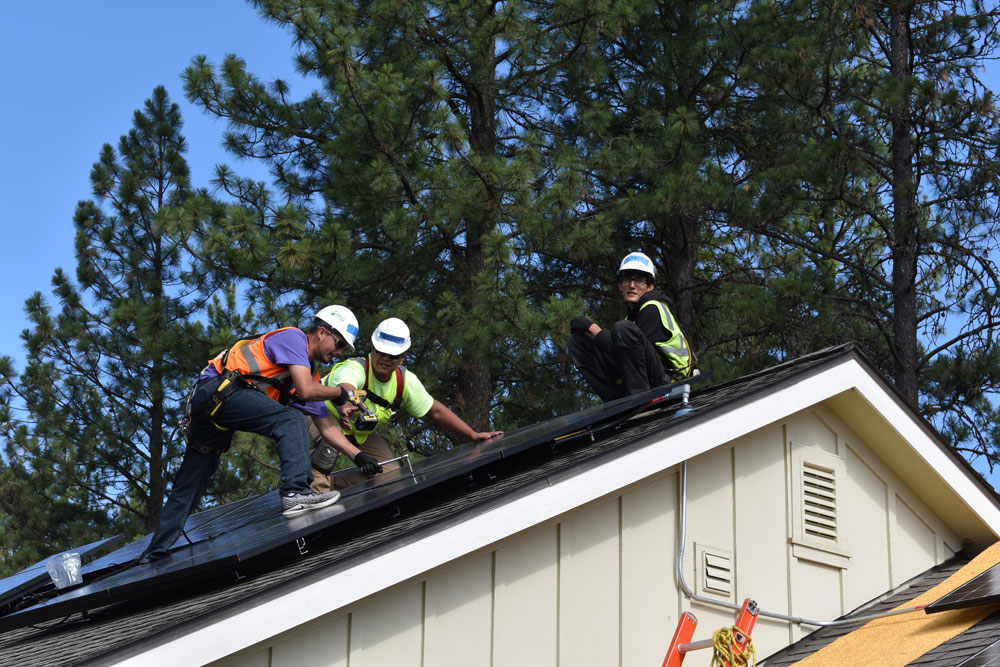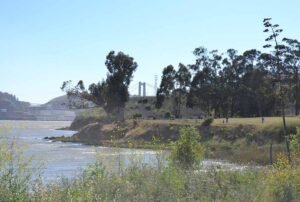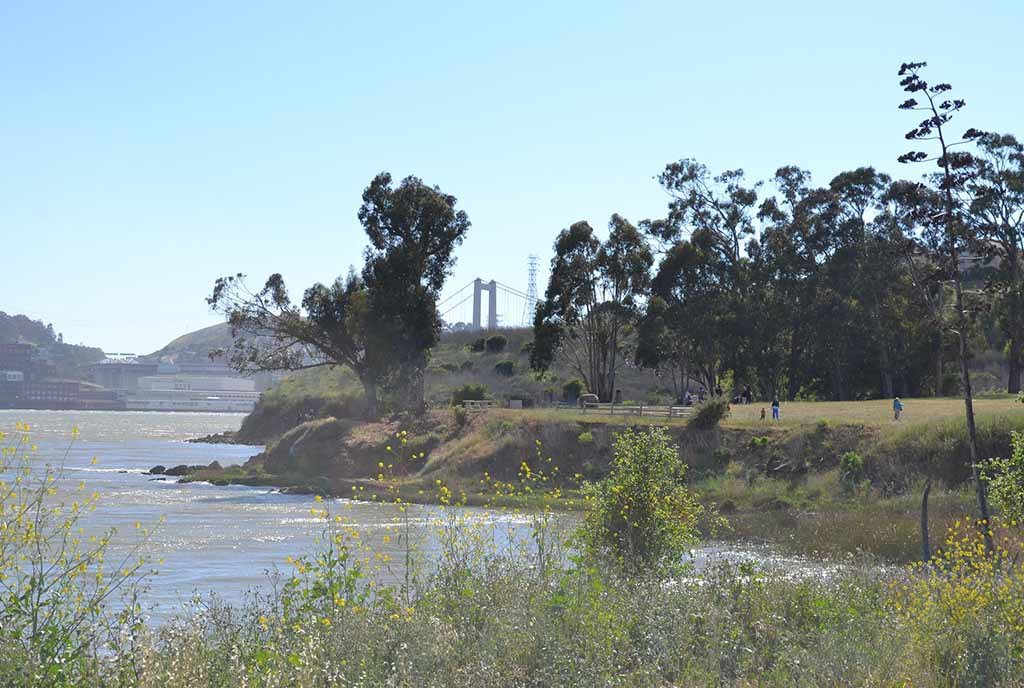

Since 2015, Jason Campbell has been CEO of Sovereign Power, an energy company that is 100 percent Spokane-owned. The company is small, but it has big plans; the idea, as Campbell puts it, is to become a “model for nation-building in the energy sector.”
The Spokane Tribe occupies over 157,000 acres of land in eastern Washington. It is bordered by the Spokane River on the south, the Columbia River on the west, and Tshimakain Creek to the east, with the 48th parallel serving as its northern boundary. Centered in Wellpinit, Washington, a small town 50 miles northwest of the city of Spokane, 2,879 people are enrolled members of the tribe as of 2017. According to the 2010 US census, 2,094 people live on Spokane land, of whom 1,661 are American Indian. The land governed by the Spokane represents a small portion of the more than three million acres originally occupied by the Spokane people.
Campbell points out that Sovereign Power was set up in 1998 as a power marketing company. (The Spokane, he says, were the first tribe in the US to do so.) The corporate structure provided a base to pursue energy sovereignty, but taking advantage of that structure requires both financial capital and a strategic vision.
As Campbell puts it, the idea is to view business opportunities “through a nation-building lens.” He elaborates, “Energy is such a critical sector. The conversation I was able to start with the tribal council was a look at the energy sector as a thing they needed to vertically control. And because I was the one with big ideas, I was asked to run it.”
According to Campbell, for Sovereign Power to realize its promise, the firm needs to engage in five areas of activity: 1) power generation (through solar installation); 2) development of the Spokane Tribe utility authority (capacity to manage distribution, operations, and maintenance); 3) power marketing (selling excess power production to the grid); 4) energy storage; and 5) legislative affairs (an ability to shape policy at the state and federal level).
There is, in short, a lot of work to do. In four years, though, there has been progress. This past summer, the company completed installation of a 643kW community-scale solar installation. It’s a small down-payment on the company’s plans to construct a 100MW solar facility in the next two-to-four years, but it’s a start. Campbell says the new installation generates enough power to serve 10 Spokane Tribe governmental buildings and 23 houses in the small town of Wellpinit.
The tribal-owned company is also looking to develop a direct combustion biomass boiler system. As Campbell mentioned to Christy Hanson in American Indian Republic in 2018, “We’ve already done the feasibility study on sustainable levels of fuel production. Even with all the wildfires we still have more than enough biomass fuel production to sustain us indefinitely.”
The biomass, Hanson explains, “would be burned in a high-efficiency biomass boiler system and converted into sustainable heat energy for specific tribal administrations, schools, and health centers as off-taker participants.”
Even with the modest scale of its current solar installation, Sovereign Power is having an impact. Campbell says they’re seeing a significant reduction in cost; this past November, he notes, a former Spokane official told him that after the solar was installed, one building had seen its utility bill, which typically would run around $2,500 that time of year, fall to just $9.
Overall, Campbell remarks, Spokane government energy costs have fallen by 80 to 90 percent since the solar panels were installed. “When you recapture that,” he says, “you have capital for training for operations and maintenance.”
Getting control over energy is part of a broader Spokane nation-building vision. Achieving economic self-sufficiency, Campbell observes, “has to start with the elected leadership looking through this lens of vertical control of critical sectors” such as water, health care, and energy.
Campbell notes that eastern Washington has suffered from wildfires, and these fires can lead to power shutoffs. This has consequences: “The vulnerable people in our community: the elders, really young kids…if there is no power, there is no way to keep medicine refrigerated. That’s really basic for sovereignty and self-determination.”
But envisioning control is only the first step, Campbell cautions. Afterward, Campbell adds, “you have to update your governance to match what you’re trying to accomplish. We have to revise a pretty skimpy utility code that we have far outpaced. We have to update the governance that regulates all of those decisions.”
Then there is the matter of local capacity building. Campbell poses the question, “How do we build out the labor force to build solar PV [photovoltaic] assets?” To do so, the Spokane have partnered with solar entities outside the Native American community to learn technical and safety skills. The Spokane, adds Campbell, still have to “build out human capacity to support the sector.”
Sign up for our free newsletters
Subscribe to NPQ's newsletters to have our top stories delivered directly to your inbox.
By signing up, you agree to our privacy policy and terms of use, and to receive messages from NPQ and our partners.
Campbell himself came to Sovereign Power through a circuitous route. Campbell left the reservation in the early 1990s to get a business undergraduate degree from Washington State University. In 2008, he got his master’s in business administration from Gonzaga University in Spokane. He then moved across the country, working with firms in Boston and Washington DC, seeking to use impact investing as a tool to improve conditions in Indian Country.
As Campbell details, “I was working on the environmental, social and governance [ESG] team of Boston Common Asset Management. They are a socially responsible impact investing institutional investor in Boston.”
Campbell adds that he came to work for Boston Common after working as a volunteer for a time with the US Social investment Forum:
The Forum at that time had an Indigenous Peoples working group that focuses on the interchange of indigenous communities and publicly traded extractive companies (timber, oil, etc.). The purpose was to be able to engage in shareholder proposals and proxy voting and doing some of those approaches with companies that historically tribes weren’t doing.
“How this ties together is that team at Boston Common,” Campbell continues. “One of the folks on the ESG team had led a campaign against Newmont Mining. Newmont is responsible for a $200 million superfund site on the Spokane Indian Reservation. We were trying to negotiate with them.” In the process, Campbell began consulting for the Spokane tribe.
Working in impact investing, Campbell notes, has helped inform his current work. It was there, Campbell says, where he learned how to build custom portfolios for tribes or high-net-worth individuals and ways to help tribal nations manage their financial assets. This experience comes in handy when you’re trying to develop a 100 MW solar project with an estimated price tag of $19 million.
The scale of the project is large, but it is not unprecedented in Indian Country. For example, a plant in Montana operated since 2015 by Energy Keepers, Inc., a company owned by the confederated Salish and Kootenai nations on Flathead reservation land, has the capacity to generate 208 MW of power.
To raise the $19 million that the Spokane power plant needs to be built requires a mix of federal New Market Tax Credits, tribal funds, philanthropic funds, impact investors, and some federal grants. Campbell estimates that so far, Sovereign Power has raised maybe a third of the money it needs.
But equally challenging to raising the funds is getting regulatory approvals. “There are laws on the books of state of Washington that directly impede the buildout of distributed power generation for tribes,” Campbell observes. The state, Campbell adds, “is now having to correct antiquated laws. A lot of those laws on the books are highly protective of investor-owned utilities.” Then, there is the federal regulator, known as the FERC or Federal Energy Regulatory Commission. Campbell notes that if you generate over 75MW of power, then you fall under federal regulation.
Additionally, because the power plant would be built on federal trust land, “it has to go through BIA [Bureau of Indian Affairs]. We’re in a public comment period for that.” The regulatory approvals, Campbell notes, along with the act of raising the funds are the most complicated parts of bringing the power plant online. By contrast, the actual construction of the power plant, which would occupy 400 acres of Spokane land, would take only 90 days, Campbell estimates.
For its own needs, the Spokane don’t need 75 MW, much less 100 MW. Campbell estimates that a third of that amount might be enough to meet direct energy needs. But the goal is much larger than that. A Spokane power plant could generate considerable income. As Campbell explains, “If you generate more than you are using, there is a market for that.… In terms of developing economies for tribes, you’re engaging in an external market and you’re pulling that revenue onto the reservation, which is the opposite of what historically happens.”
Another goal is job creation—not just in construction, but in operations and maintenance of the system. Campbell adds, “On the biomass side, we are extending the job creation from the timber industry. We are taking what’s typically a unused waste product and creating a quantified marketable product in the form of fuel that we are using.”
Campbell views the Spokane effort as part of a broader community of American Indian initiatives to achieve energy sovereignty—initiatives that often support one another. In addition to Energy Keepers, Campbell mentioned Warm Springs Power in Oregon (southeast of Portland and jointly managed by the Wasco, Paiute, and Warm Springs nations) and Yakama Power, managed by the Yakama nation, which is located south of the city of Yakima in south central Washington.
As Campbell told Hanson in 2018, “Tribes are becoming more sophisticated. There’s a growing number of tribes that have the capacity to serve in mentor-protégé models… As we move into the future, that model is expanding. We blend our historic values with contemporary values.”













